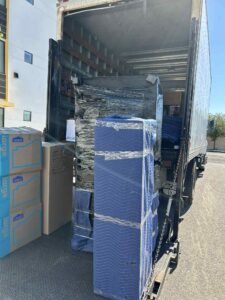Moving your business to a new location represents one of the most significant transitions you’ll face as a business owner. Whether you’re expanding operations, seeking better facilities, or relocating for strategic advantages, a commercial move requires meticulous planning and execution. Unlike residential relocations, business moves involve complex logistics, valuable equipment, sensitive documents, and the challenge of maintaining operations during the transition.
The stakes are considerably higher when relocating a business. Every day of downtime translates to lost revenue, disrupted customer relationships, and potential damage to your reputation. This comprehensive guide provides you with eight essential steps to ensure your commercial relocation proceeds smoothly, minimizes business interruption, and sets your company up for success in its new location.
Step 1: Create a Comprehensive Moving Timeline
Establishing a detailed timeline serves as the foundation for your entire relocation project. Begin planning at least three to six months before your intended move date, depending on the size and complexity of your business operations. This extended timeline allows you to address unexpected challenges and coordinate multiple moving parts without rushing critical decisions.
Start by identifying key milestones and working backward from your target move date. Consider factors such as lease expiration dates, seasonal business fluctuations, and major projects or deadlines that could conflict with your move. Create a master calendar that includes all departments, vendors, and stakeholders involved in the relocation process.
Your timeline should account for various phases of the move, including initial planning, vendor selection, packing preparation, the actual moving day, and post-move setup. Build in buffer time for each phase to accommodate delays or complications that commonly arise during commercial relocations.
Document everything in writing and share the timeline with all relevant team members. Regular updates and communication ensure everyone stays aligned with the moving schedule and can adjust their responsibilities accordingly. Consider using project management software to track progress and maintain accountability across your organization.
Step 2: Establish Your Moving Budget and Secure Funding
Commercial moves involve substantial financial investment beyond the obvious moving company fees. Develop a comprehensive budget that encompasses all relocation-related expenses to avoid unexpected costs that could strain your business finances.
Your budget should include direct moving costs such as professional moving services, packing supplies, and transportation fees. Factor in indirect expenses like temporary storage, equipment installation, utility setup fees, and potential business interruption costs. Don’t overlook renovation expenses, new furniture purchases, or technology upgrades required for your new location.
Consider the cost of employee time dedicated to packing, unpacking, and setting up the new workspace. Calculate potential revenue losses from business downtime and include contingency funds for unexpected expenses that typically arise during commercial moves.
Obtain multiple quotes from reputable moving companies to establish realistic cost expectations. Professional movers like My Tucson Movers can provide detailed estimates that help you understand the full scope of moving expenses and plan accordingly.
Research available tax deductions for business moving expenses, as many relocation costs qualify for business tax write-offs. Consult with your accountant to maximize potential savings and ensure proper documentation for tax purposes.
Step 3: Research and Select Your Moving Company
Choosing the right commercial moving company directly impacts the success of your relocation. Professional commercial movers possess specialized expertise, equipment, and experience necessary to handle complex business moves efficiently and safely.
Begin your search by researching moving companies that specialize in commercial relocations rather than general household moves. Commercial moves require different skills, equipment, and insurance coverage compared to residential relocations. Look for companies with proven track records in handling businesses similar to yours in size and industry.
Verify proper licensing and insurance coverage for all potential moving companies. Commercial movers should carry adequate liability insurance and workers’ compensation coverage to protect your business assets and employees during the relocation process. Request certificates of insurance and confirm coverage amounts meet your business requirements.
Request detailed written estimates from multiple moving companies, ensuring each quote includes the same services and specifications for accurate comparison. Professional movers should conduct on-site assessments to provide accurate estimates based on your specific moving requirements.
Review customer testimonials, online reviews, and references from previous commercial clients. Contact references directly to inquire about their experience, professionalism, and ability to meet deadlines. Pay attention to how moving companies handle customer service inquiries, as communication quality often reflects overall service delivery.
Step 4: Notify Stakeholders and Update Business Information
Effective communication with all stakeholders ensures smooth transitions and maintains business relationships throughout your relocation. Create a comprehensive list of everyone who needs advance notification about your move, including customers, vendors, employees, and service providers.
Develop a communication strategy that provides appropriate notice to different stakeholder groups. Customers typically require the most advance notice to update their records and adjust delivery schedules. Vendors and suppliers need sufficient time to update shipping addresses and coordinate deliveries to your new location.
Update your business address across all platforms and documentation well before your move date. This includes business registration documents, tax records, bank accounts, insurance policies, and loan agreements. Contact your attorney to ensure all legal documents reflect your new business address.
Modify your business address on marketing materials, websites, social media profiles, and online directories. Submit change of address notifications to the postal service and coordinate mail forwarding to prevent important correspondence from being lost during the transition.
Notify utility companies, internet service providers, and other essential services about your move date to schedule disconnection at your current location and connection at your new address. According to the Small Business Administration, proper utility coordination prevents costly delays and ensures your business can resume operations quickly.
Step 5: Organize and Secure Important Documents
Business documents contain irreplaceable information that requires special handling during commercial moves. Create a comprehensive inventory of all important documents and implement secure procedures for packing, transporting, and organizing these materials.
Categorize documents by importance and frequency of use to prioritize packing and unpacking procedures. Essential documents that you need immediate access to should be packed separately and transported personally or through secure courier services rather than with general office materials.
Important business documents include:
• Financial records and accounting documents • Legal contracts and agreements
• Employee personnel files and records • Insurance policies and certificates • Intellectual property documentation • Regulatory licenses and permits • Customer and vendor contact information • Banking and investment account records
Consider digitizing important documents before your move to create backup copies and reduce physical storage requirements. Digital copies provide additional security and make documents more accessible in your new location. However, maintain original hard copies of documents that require physical originals for legal purposes.
Use professional-grade file boxes and clearly label all document containers with detailed contents lists. Create a master inventory that tracks box locations and contents to facilitate quick document retrieval after your move.
Step 6: Prepare Your Technology and Equipment
Technology infrastructure requires careful planning and coordination to minimize business disruption during your commercial move. Modern businesses depend heavily on computer systems, telecommunications, and specialized equipment that need professional handling and proper setup procedures.
Conduct a comprehensive audit of all technology assets including computers, servers, networking equipment, telephone systems, and specialized machinery. Document serial numbers, warranties, and setup configurations to facilitate reinstallation at your new location.
Coordinate with your IT department or technology vendors to plan the disconnection, transportation, and reinstallation of computer systems and networking equipment. Many technology components require specific environmental conditions and professional installation to function properly.
Back up all computer data and systems before disconnecting equipment for transportation. Store backup copies in secure, separate locations to prevent data loss if equipment is damaged during the move. Test backup systems to ensure data integrity and completeness before relying on them for business operations.
Schedule utility connections and internet service installation at your new location well in advance of your move date. Technology infrastructure often requires lead time for installation and testing, so early coordination prevents delays in resuming business operations.
Step 7: Plan Your Moving Day Logistics
Moving day coordination determines whether your commercial relocation proceeds smoothly or encounters costly delays and complications. Develop detailed logistics plans that address timing, personnel assignments, and contingency procedures for your moving day.
Create floor plans and equipment placement diagrams for your new location before moving day arrives. Share these plans with your moving team to ensure efficient unloading and setup procedures. Clear diagrams prevent confusion and reduce the time required to position furniture and equipment in their final locations.
Assign specific responsibilities to key personnel who will oversee different aspects of the moving process. Designate supervisors for packing oversight, equipment handling, document security, and coordination with the moving crew. Having clear leadership prevents miscommunication and ensures accountability during the relocation.
Prepare your current location for efficient loading by clearing pathways, protecting floors and walls, and ensuring adequate parking space for moving trucks. Remove obstacles that could slow down the moving process or create safety hazards for moving personnel.
Pack a “first day” survival kit containing essential supplies, important documents, and basic equipment needed to resume critical business functions immediately upon arrival at your new location. This kit should include office supplies, basic tools, cleaning materials, and refreshments for your team.
Step 8: Execute Your Post-Move Setup and Operations
The period immediately following your physical move requires focused attention to resume normal business operations quickly and efficiently. Successful post-move execution minimizes downtime and helps your team adapt to the new work environment.
Prioritize the setup of essential systems and equipment that support your core business functions. Focus first on technology infrastructure, telecommunications, and any specialized equipment required for daily operations. Secondary priorities include furniture arrangement, storage organization, and aesthetic improvements.
Conduct thorough testing of all systems and equipment to identify any issues that occurred during transportation or reinstallation. Address problems immediately to prevent extended downtime that could impact customer service or business productivity.
Organize a comprehensive walkthrough of your new location with key personnel to familiarize everyone with the layout, safety procedures, and emergency protocols. Ensure all employees know the locations of restrooms, exits, break rooms, and important equipment.
Update your business operations manual and employee handbook to reflect procedures and policies specific to your new location. Address any changes in workflow, security procedures, or daily routines that result from the new office layout or neighborhood.
Monitor your business operations closely during the first few weeks after your move to identify and address any issues that affect productivity, customer service, or employee satisfaction. Gather feedback from employees and customers to understand how the move has impacted their experience and make necessary adjustments.
Conclusion
Successfully relocating your business requires thorough planning, professional expertise, and careful attention to detail throughout the entire process. These eight steps provide a comprehensive framework for managing your commercial move while minimizing business disruption and ensuring a smooth transition to your new location.
Remember that every business move presents unique challenges and opportunities. Adapt these guidelines to fit your specific industry requirements, company size, and operational needs. The investment in proper planning and professional moving services pays dividends through reduced downtime, protected assets, and faster return to normal business operations.
Working with experienced commercial movers like My Tucson Movers provides the expertise and resources necessary to execute your relocation plan successfully. Professional movers understand the complexities of commercial relocations and can help you navigate the challenges while protecting your valuable business assets throughout the moving process.



